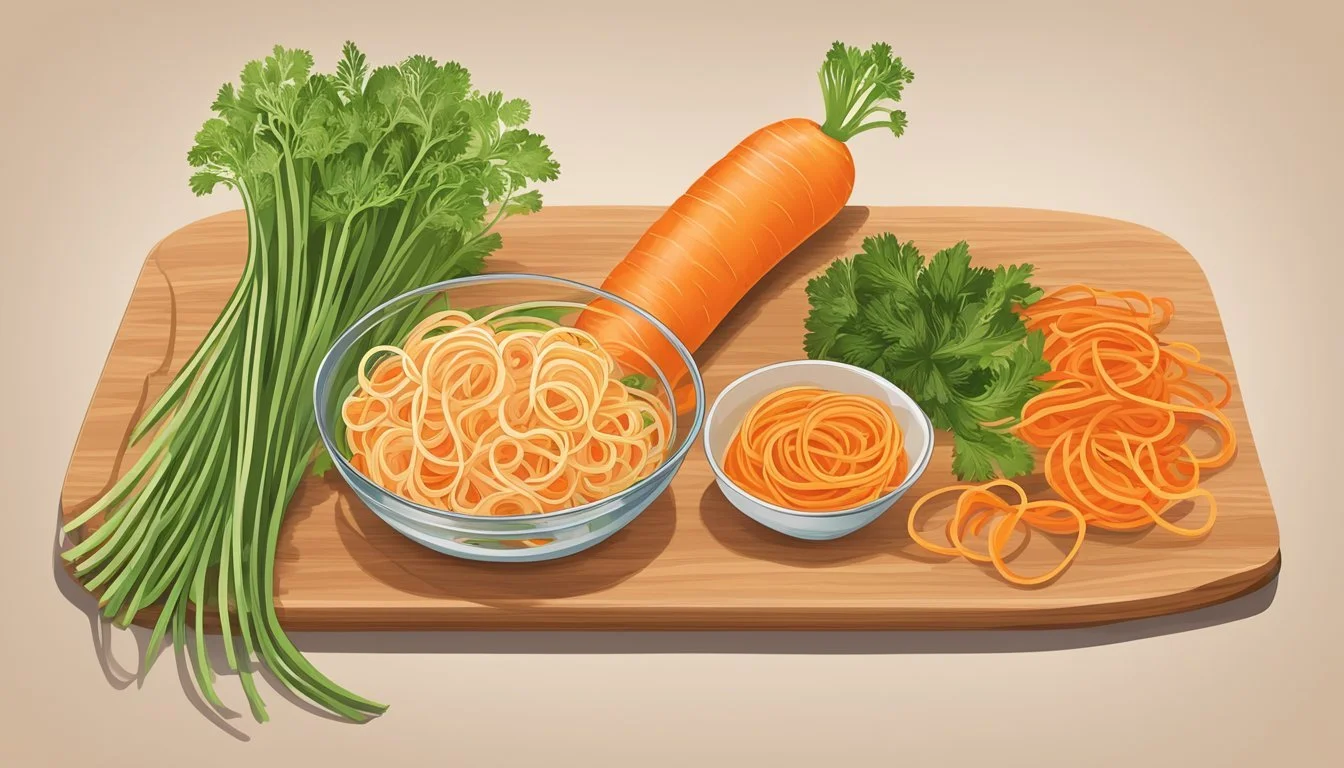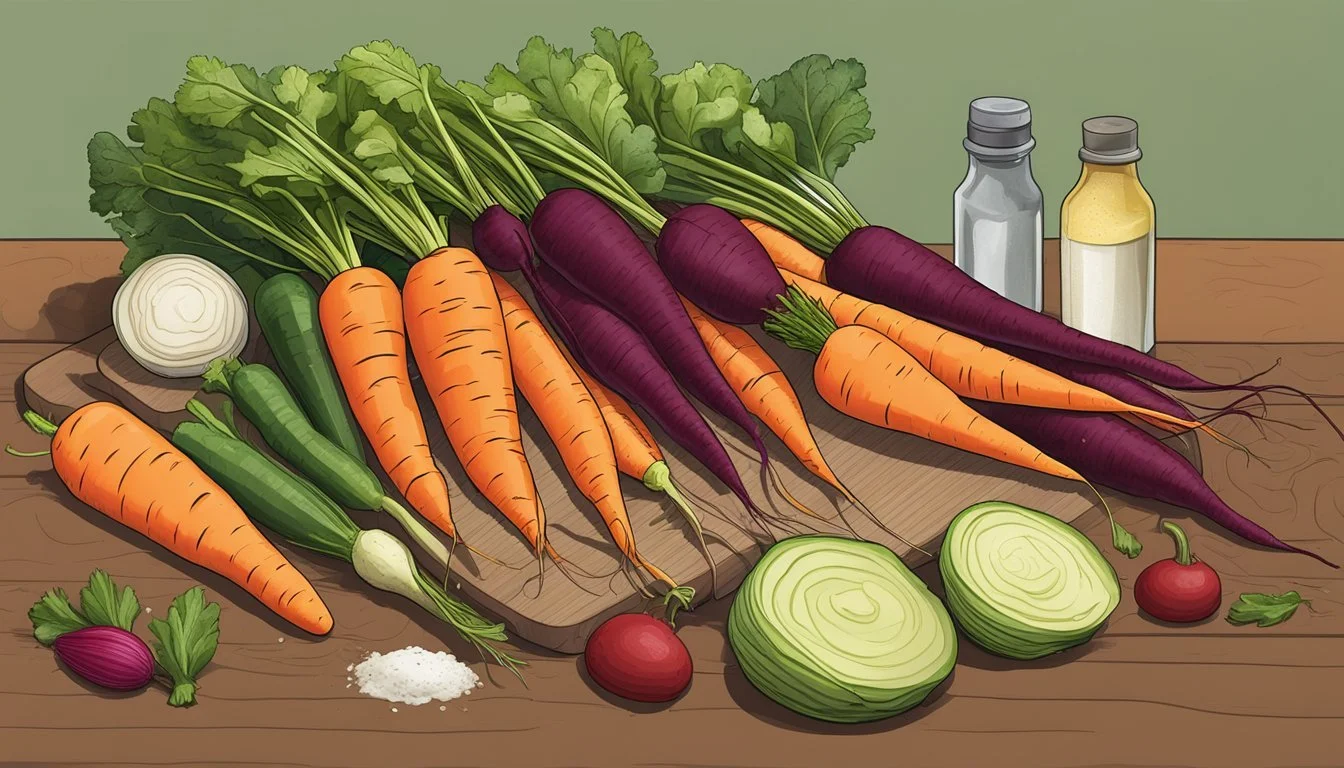Carrot Noodle Substitutes
Top Alternatives for Healthy Eating
Exploring alternative options for carrot noodles is a creative way to diversify the nutritional profile and textures in your meals. Vegetables offer a wide range of health benefits, including being rich in fiber, vitamins, and antioxidants, which support overall well-being. When carrot noodles are not available, or a change is desired, there are several other vegetables that can provide similar nutritional benefits while also adding variety to your dishes.
One popular carrot noodle substitute is zucchini. When spiralized, zucchini transforms into a soft and mild-flavored noodle alternative that pairs excellently with a wide array of sauces and seasonings. This vegetable is not only low in calories, but also contains a respectable amount of fiber and vitamins, such as vitamin C and potassium. Zucchini noodles, commonly known as 'zoodles', are a nutritious option that can be quickly blanched or sautéed for a tender yet al dente texture.
Nutritional Benefits of Carrot Noodles
Carrot noodles are a highly nutritious and low-carb alternative to traditional pasta. Packed with fiber, essential vitamins, and antioxidants, they provide a wealth of health benefits.
Fiber Content in Carrot Noodles
Carrot noodles are an excellent source of dietary fiber. They aid in maintaining a healthy digestive system and can contribute to a feeling of fullness, which may be beneficial for weight management. A single cup of carrot noodles can contain as much as 2-3 grams of fiber, making it a substantial contributor to the daily recommended fiber intake.
Vitamins and Antioxidants
Carrot noodles are not just low in carbohydrates; they are also rich in vitamins and antioxidants. They contain high levels of vitamin A, primarily in the form of beta-carotene, a powerful antioxidant that supports eye health and boosts the immune system. Additionally, carrot noodles provide other essential nutrients such as vitamin C, vitamin K, and B-vitamins, which are crucial for blood clotting, energy production, and maintaining optimal health.
Carrot Noodle Cooking Techniques
Carrot noodles are a versatile alternative to traditional pasta, offering a sweet taste and nourishing benefits. When cooked properly, they provide a delightful texture that can hold up well to a variety of sauces and seasonings.
Best Methods for Preparing Carrot Noodles
Carrot noodles can be made in several ways, but the most common method is to use a spiralizer or a vegetable peeler. For a simple, rustic approach, peeling carrots into ribbons works well and requires no special equipment. Spiralizers, on the other hand, create a more uniform noodle shape that is ideal for mimicking the texture of traditional pasta. Once the noodles are prepared, cooking them to the perfect al dente texture is key to a satisfying dish.
Maintaining Texture and Flavor
Proper cooking techniques are crucial for maintaining the sweet flavor and desirable texture of carrot noodles. Here are some methods to ensure they turn out just right:
Steaming: A gentle method that preserves the color and nutrients, and imparts a subtle sweetness. Steaming for 3-5 minutes can result in tender yet slightly firm noodles.
Sautéing: Heat some oil in a skillet over medium heat, then add the noodles. Sauté for 5-7 minutes for a firmer, more textured noodle.
Roasting: For deeper sweetness and a slight char, spread the noodles on a baking sheet, drizzle with oil, and roast at 400 degrees F for 10-15 minutes.
Boiling: Not recommended, as it can make the noodles mushy and waterlogged.
Each method offers a different texture and intensity of flavor, so the choice depends on the desired outcome and the accompanying sauce or ingredients.
Choosing Substitutes for Carrot Noodles
When looking for alternatives to carrot noodles, one can explore a variety of vegetable, grain-based, legume, and specialized low-carb or gluten-free options, each offering unique nutritional profiles and textures suitable for pasta dishes.
Vegetable Alternatives
Vegetables make for excellent substitutes, particularly for those seeking low-carbohydrate and gluten-free noodle options. Zucchini noodles, commonly known as "zoodles," are a popular choice and can be easily made with a spiralizer to mimic the texture and shape of traditional noodles. Other vegetables such as cauliflower and cabbage can also serve as pasta substitutes, with cauliflower noodles providing a mild flavor and cabbage offering a subtly sweet taste, while maintaining a pasta-like consistency.
Grain-Based and Legume Noodles
For those not strictly adhering to a low-carb diet, noodles made from grains and legumes may be a desirable alternative. Black bean spaghetti is an intriguing option; it is made from black bean flour and contains about eight grams of net carbs per serving. Grain-based noodles incorporate a variety of flours, and while they might be higher in carbohydrates compared to vegetable alternatives, they can offer greater protein content and a richer flavor.
Low Carb and Gluten-Free Options
Consumers now have an array of low-carb and gluten-free pasta substitutes at their disposal apart from vegetable noodles. Many of these options strive to replicate the texture and flavor of traditional pasta while reducing carbohydrate content significantly. Seek out products specifically labeled as low-carb or gluten-free to ensure they meet the necessary dietary requirements.
Preparation Tips for Substitutes
When seeking alternatives to carrot noodles, it's important to consider how substitutes can match the nutritional profile and cooking versatility of carrots. The right preparation methods ensure that these alternatives provide both a satisfying texture and beneficial nutrients.
Maintaining Nutritional Value
Spiralized Vegetables: Vegetables such as zucchini, squash, and sweet potatoes can be spiralized to create low-calorie noodle substitutes. They maintain an array of vitamins and minerals comparable to carrots. A spiralizer is essential to transform these vegetables into noodle-like strands.
Vegetable Vitamin A Vitamin C Fibre Zucchini Low Moderate High Squash High High High Sweet Potato High Moderate High
Parboiling: For harder vegetables like sweet potatoes, parboiling before spiralizing can soften the texture, making it closer to that of cooked carrot noodles without causing a significant loss of nutrients.
Cooking Methods for Alternatives
Sautéing: This method works well for softer substitutes like zucchini. Sauté briefly to retain a subtle flavor and prevent the noodles from becoming mushy. Sautéing is excellent for achieving an earthy flavor and a texture that isn't overly soft.
Roasting: For a more pronounced flavor, roasting is suitable for sweet potatoes and squash. Cut them into uniform sizes for even cooking. Roasting intensifies the natural sweetness and provides a caramelized exterior.
Storage Solutions for Noodles and Substitutes
Proper storage of noodles and their substitutes is crucial for maintaining their quality and extending shelf life. The two main storage strategies involve managing the environment to reduce spoilage and using appropriate containers.
Extending Freshness
For most noodle types, particularly fresh noodles with a high water content, reducing exposure to air is key. Oxygen can lead to the growth of bacteria and mold, which deteriorate the product. To extend the freshness of noodles and their substitutes, such as carrot noodles, one should minimize their time at room temperature after cooking or opening the package.
Uncooked Dry Noodles: Store in a cool, dry place in their original packaging, or transfer to an airtight container if opened.
Fresh or Cooked Noodles: Refrigerate within two hours of cooking or opening, ideally in sealed containers to prevent drying out and absorbing other flavors.
Airtight Containers and Refrigeration
Using airtight containers is the best practice for refrigerating noodles. They prevent moisture loss, protect against contaminants, and keep odors from permeating the noodles.
Airtight Container: Choose containers that have tight-sealing lids. Glass containers are preferred due to their non-porous nature, which prevents them from absorbing flavors.
Refrigerator Settings: Store noodles at temperatures below 40°F. Monitor the refrigerator's humidity to avoid condensation, which can affect the noodles’ texture.
Substitutions:
If one runs out of airtight containers, heavy-duty plastic bags with zip closures can be a temporary solution. They must be sealed properly and contain as little air as possible.
When storing substitutions like vegetable noodles (e.g., carrot noodles), consider their water content. Higher water content may lead to quicker spoilage, meaning these should ideally be consumed sooner rather than later.
Incorporating Substitutes into Dishes
When incorporating substitutes for carrots into various dishes, one must consider how these alternatives affect the nutritional balance, taste, and texture of the meal. This section outlines the process of using different ingredients to maintain the integrity of dishes such as salads, soups, and carrot cake, ensuring they cater to dietary needs and preferences.
Creating Balanced Meals
A critical aspect of substituting carrots in a dish is to uphold the meal's nutritional value. For example:
In salads, jicama can replace carrots to provide a similar crunch and fiber content.
In soups, sweet potatoes can be an excellent substitute, as they bring a comparable color and a sweet, earthy flavor, along with essential nutrients like beta-carotene.
While carrots often contribute to the sweetness in carrot cake, the use of puréed sweet potatoes can offer a similar texture and natural sweetness, plus an additional boost of vitamins.
For entrées such as lasagna and bolognese, one can utilize substitutes like squash to add the desired bulk and fiber. The substitution can be especially beneficial for those managing diabetes, as it can help control blood sugar levels due to lower glycemic index ingredients.
Recipe Adaptations for Dietary Needs
When modifying recipes to account for dietary needs, consider the health benefits and restrictions:
For diners managing cancer, incorporating nutrient-dense substitutes like sweet potatoes can offer vital antioxidants without sacrificing taste.
Individuals with diabetes may prefer substitutes that are lower in sugars and have a more favorable impact on blood sugar levels, such as radishes or celery.
Here is a quick guide to appropriate carrot substitutes based on dietary considerations:
Dish Type Carrot Substitute Benefit Salads Jicama, Radishes Low-calorie, crunchy texture, fiber-rich Soups Sweet potatoes Nutrient-dense, sweet flavor, beta-carotene Bolognese Squash Adds bulk, fiber, and moisture Carrot Cake Sweet potatoes Natural sweetness, moistness, nutrients Lasagna Squash Lower glycemic index, texture, fiber
Adaptations for those with specific health conditions should prioritize substitutes that align with their dietary guidelines while maintaining the integrity and enjoyment of the meal.
Seasoning and Flavoring Tips
When selecting seasonings for carrot noodle substitutes, it's crucial to strike a balance that enhances the natural sweetness without overshadowing the primary flavors of the dish.
Enhancing Taste without Overpowering
Butter and olive oil are foundational ingredients that can be used to gently elevate the intrinsic sweetness of carrot noodle substitutes. For example, a modest amount of butter can add a subtle richness without dominating the dish. On the other hand, olive oil is preferred for its versatility and ability to infuse herbs and spices into the noodles. A squeeze of lemon can introduce a bright, acidic counterpoint to the sweetness, providing a harmonious balance between sweet and bitter elements.
Butter: Use sparingly to avoid excessive richness.
Olive Oil: A drizzle can carry flavors and create a luxurious mouthfeel.
Lemon: A zest or a splash can cut through sweetness and add vibrancy.
Choosing Complementary Herbs and Spices
The selection of herbs and spices can make or break a dish. For carrot noodle substitutes, one might consider a pinch of nutmeg to accentuate the noodles' earthy notes; pepper to add a sharp counterbalance that complements the natural sweetness without overwhelming it.
Nutmeg: Enhance earthiness with a light dusting.
Pepper: Black pepper for heat, white pepper for subtlety.
By carefully choosing herbs and spices, one can craft a nuanced flavor profile that complements the base ingredient, whether aiming for a sweeter or more savory dish. It's essential to use aromatic compounds like herbs judiciously; they should act as accents rather than primary flavors.






